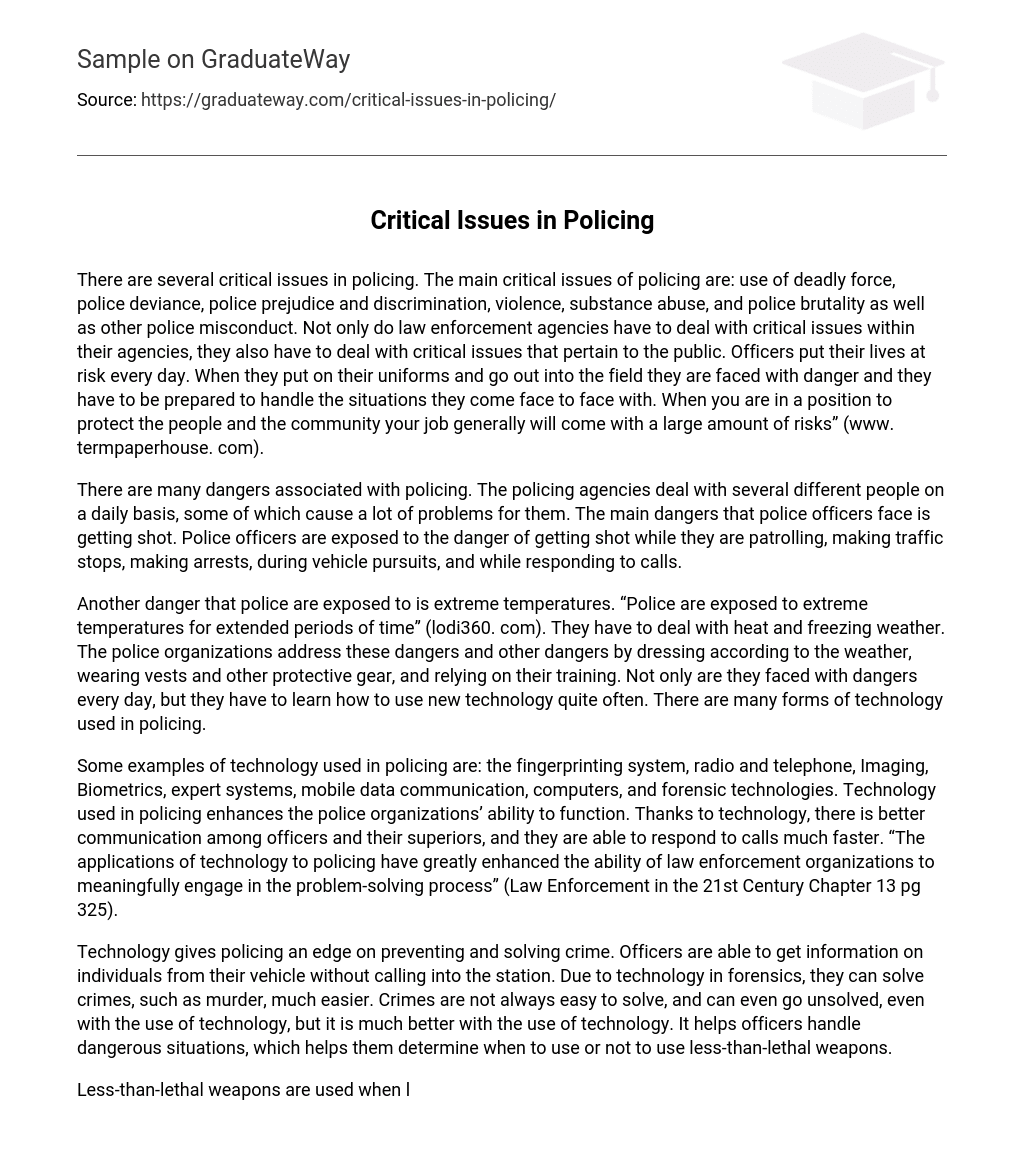There are numerous significant issues in policing, including the use of deadly force, police deviance, prejudice and discrimination, violence, substance abuse, and police brutality. These issues, along with other forms of police misconduct, constitute the main critical issues faced in law enforcement agencies. In addition to addressing these internal concerns, law enforcement agencies also face critical issues involving the public they serve. Police officers willingly risk their lives every day when they put on their uniforms and venture into the field. They must be prepared to handle various situations that may pose dangers. Being in a position to safeguard individuals and communities often comes with a substantial amount of risks” (www.termpaperhouse.com).
Policing entails numerous risks as agencies interact with diverse individuals on a daily basis, some of whom pose significant challenges. The primary danger faced by police officers is the risk of being shot. Their vulnerability to gunfire exists while patrolling, conducting traffic stops, making arrests, engaging in vehicle pursuits, and responding to calls.
Police officers face a range of risks, including prolonged exposure to extreme temperatures (lodi360.com). They experience both hot and cold weather conditions. To manage these dangers, as well as other hazards, police organizations provide officers with suitable clothing and protective gear that is designed for the prevailing weather conditions. Additionally, they depend on their training to reduce risks. Moreover, police officers not only encounter daily hazards but also frequently need to learn about new technologies. Policing involves various types of technology.
Technology plays a crucial role in policing, offering various tools and systems that enhance operational effectiveness. Some examples of these technological advancements include the fingerprinting system, radio and telephone communication, imaging technology, biometrics, expert systems, mobile data communication devices such as smartphones, computers for efficient data processing and analysis, as well as forensic technologies.
The utilization of technology in law enforcement has resulted in improved communication between officers and their superiors. This enables faster response times to emergency calls or incidents. Additionally, the integration of technology into policing has been found to significantly enhance the capability of law enforcement organizations to effectively address problems. According to Law Enforcement in the 21st Century Chapter 13 pg 325,
Technology plays a crucial role in enhancing police efforts to prevent and solve crime. It enables officers to retrieve personal information directly from their vehicles, eliminating the need for interaction with the police station. Furthermore, advancements in forensic technology simplify the resolution of complex crimes like murder. While certain crimes may remain challenging to crack and could go unresolved, utilizing technology greatly enhances the likelihood of successful resolutions. Additionally, technology assists officers in managing dangerous situations and making informed decisions regarding non-lethal weapons usage.
Non-lethal weapons, including tasers, stun guns, pepper spray, rubber bullets, nets, and handcuffs, are used when lethal force is deemed inappropriate for subduing a criminal or aggressive individual without causing death. Although there is no guarantee of avoiding fatalities from their use, employing these weapons has been linked to reduced instances of deaths. By utilizing non-lethal weapons, law enforcement officers can effectively handle situations using the suitable level of force.
The book “Law Enforcement in the 21st Century” (Chapter 11, pg 264) emphasizes the significance of officers being attentive to suspect behavior and understanding the proper level of coercive force. Similar to lethal weapons, it is crucial to exercise caution when utilizing less-than-lethal weapons, taking into account factors such as method, timing, and location. Misusing these weapons can cause harm to innocent bystanders. Furthermore, using less-than-lethal weapons improperly or at close range also puts the suspect at risk of injury or even death.
Officers must receive training in weapon usage, which includes effective utilization, understanding appropriate situations for their use, and selecting the right weapon for specific circumstances. Additionally, officers need to be able to assess the best approach accurately. These situations can be highly perilous and occasionally necessitate employing lethal force for criminal apprehension. Nevertheless, officers aim to minimize force whenever feasible. Their training provides them with essential abilities to handle diverse scenarios.
Regardless of the situation or technological advancements, police officers will always face dangers and must be prepared to handle critical issues. These dangers include being shot, encountering contagious diseases, and the potential for accidents while pursuing vehicles. Additionally, officers may develop poor eating habits and face other health concerns. Furthermore, there is the risk of harm or even death when making arrests or conducting traffic stops.
Although police officers receive training and learn safety precautions, their protection from danger or critical problems is not guaranteed. Every day, they encounter potential risks to their lives while performing their duties in the field. Dealing with critical issues is a core component of policing that demands various approaches at different levels. Police organizations must be adequately prepared to address any situation that arises. While it may be difficult to fully anticipate every scenario, especially during emergencies, officers are trained in effectively managing these critical issues to the best of their abilities.
Every day, police officers must be prepared to handle critical issues, danger, and utilize the technology associated with their profession. They must possess the skills to protect and defend themselves, manage aggressive individuals, safeguard the community, and responsibly employ less-than-lethal weapons. In their pursuit of duty, officers confront perilous situations and face the constant risk of injury or death.





